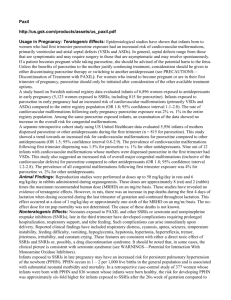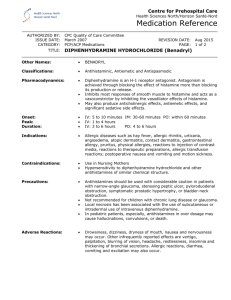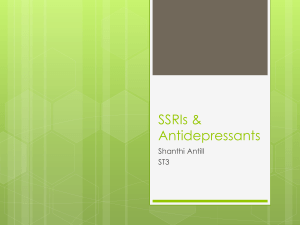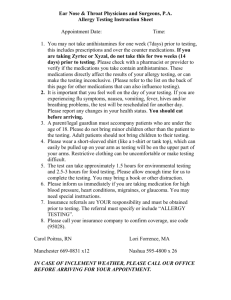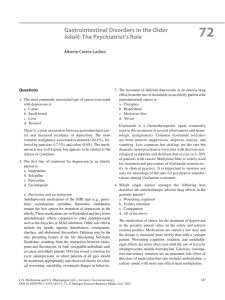Multiple drug poisoning case caused by a pharmacokinetic
advertisement
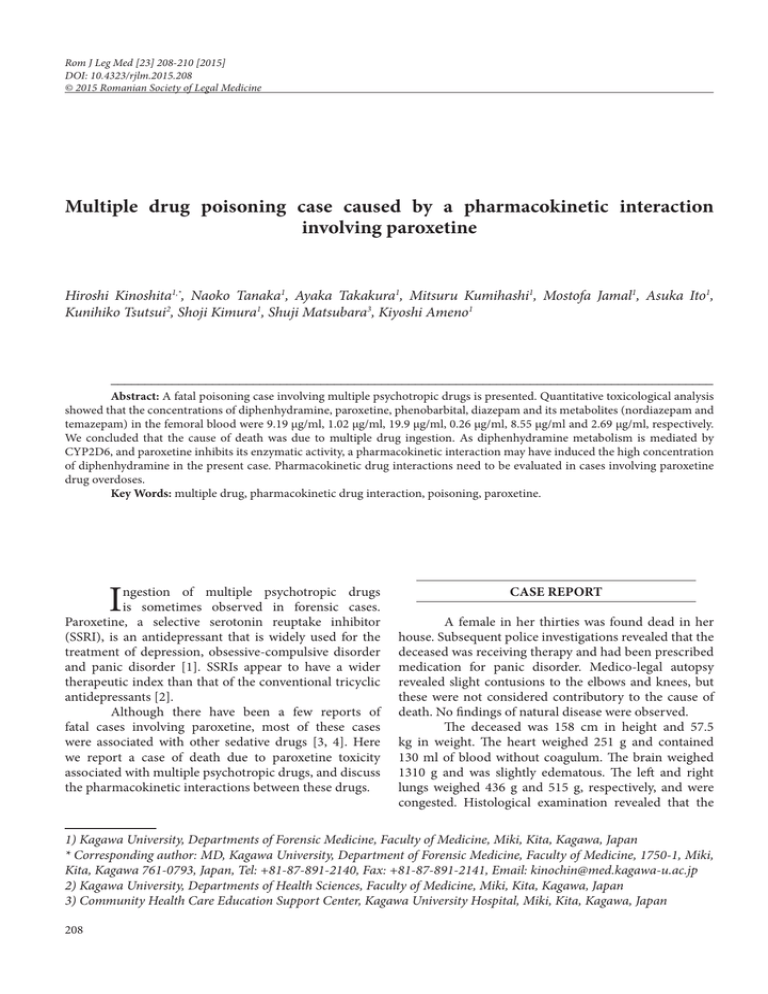
Rom J Leg Med [23] 208-210 [2015] DOI: 10.4323/rjlm.2015.208 © 2015 Romanian Society of Legal Medicine Multiple drug poisoning case caused by a pharmacokinetic interaction involving paroxetine Hiroshi Kinoshita1,*, Naoko Tanaka1, Ayaka Takakura1, Mitsuru Kumihashi1, Mostofa Jamal1, Asuka Ito1, Kunihiko Tsutsui2, Shoji Kimura1, Shuji Matsubara3, Kiyoshi Ameno1 _________________________________________________________________________________________ Abstract: A fatal poisoning case involving multiple psychotropic drugs is presented. Quantitative toxicological analysis showed that the concentrations of diphenhydramine, paroxetine, phenobarbital, diazepam and its metabolites (nordiazepam and temazepam) in the femoral blood were 9.19 µg/ml, 1.02 µg/ml, 19.9 µg/ml, 0.26 µg/ml, 8.55 µg/ml and 2.69 µg/ml, respectively. We concluded that the cause of death was due to multiple drug ingestion. As diphenhydramine metabolism is mediated by CYP2D6, and paroxetine inhibits its enzymatic activity, a pharmacokinetic interaction may have induced the high concentration of diphenhydramine in the present case. Pharmacokinetic drug interactions need to be evaluated in cases involving paroxetine drug overdoses. Key Words: multiple drug, pharmacokinetic drug interaction, poisoning, paroxetine. I ngestion of multiple psychotropic drugs is sometimes observed in forensic cases. Paroxetine, a selective serotonin reuptake inhibitor (SSRI), is an antidepressant that is widely used for the treatment of depression, obsessive-compulsive disorder and panic disorder [1]. SSRIs appear to have a wider therapeutic index than that of the conventional tricyclic antidepressants [2]. Although there have been a few reports of fatal cases involving paroxetine, most of these cases were associated with other sedative drugs [3, 4]. Here we report a case of death due to paroxetine toxicity associated with multiple psychotropic drugs, and discuss the pharmacokinetic interactions between these drugs. Case Report A female in her thirties was found dead in her house. Subsequent police investigations revealed that the deceased was receiving therapy and had been prescribed medication for panic disorder. Medico-legal autopsy revealed slight contusions to the elbows and knees, but these were not considered contributory to the cause of death. No findings of natural disease were observed. The deceased was 158 cm in height and 57.5 kg in weight. The heart weighed 251 g and contained 130 ml of blood without coagulum. The brain weighed 1310 g and was slightly edematous. The left and right lungs weighed 436 g and 515 g, respectively, and were congested. Histological examination revealed that the 1) Kagawa University, Departments of Forensic Medicine, Faculty of Medicine, Miki, Kita, Kagawa, Japan * Corresponding author: MD, Kagawa University, Department of Forensic Medicine, Faculty of Medicine, 1750-1, Miki, Kita, Kagawa 761-0793, Japan, Tel: +81-87-891-2140, Fax: +81-87-891-2141, Email: kinochin@med.kagawa-u.ac.jp 2) Kagawa University, Departments of Health Sciences, Faculty of Medicine, Miki, Kita, Kagawa, Japan 3) Community Health Care Education Support Center, Kagawa University Hospital, Miki, Kita, Kagawa, Japan 208 Romanian Journal of Legal Medicine lungs showed marked congestion and edema. There were no notable changes, other than congestion in the other organs. A drug screening test using a TriageTM (Biosite Diagnostic Inc., San Diego, CA, USA) panel was positive for barbiturates and benzodiazepines. Postmortem blood and urine samples were collected for toxicological investigation. Toxicological analysis using gas chromatography mass spectrometry (GC-MS) was performed using a slightly modified method from a previous report [5]. Quantitation of ethanol was performed using headspace gas chromatography. Results and Discussion Toxicological analysis identified diphenhydramine, paroxetine, phenobarbital, diazepam and its metabolites (nordiazepam and temazepam). No ethanol was detected in the blood. Table 1 shows the quantification for each drug in the victim’s blood along with the currently established fatal and therapeutic levels [6]. Analytical results indicated a fatal level of diphenhydramine and a toxic level of paroxetine present; while phenobarbital and diazepam were within normal therapeutic ranges. Among the detected drugs, paroxetine is a phenylpiperidine derivative [1] that is both a substrate and a potent inhibitor of cytochrome P450 2D6 (CYP2D6), and a weak inhibitor of CYP3A4 [3]. As paroxetine can cause an accumulation of drugs that are metabolized by CYP2D6 and CYP3A4 and lead to toxic concentrations, drug-drug interactions are important and need to be carefully considered in these types of cases [1, 3]. Diphenhydramine is a histamine H1 receptor antagonist that is widely used for the treatment of allergic diseases, with its metabolism mainly mediated by CYP2D6 [7]. The postmortem blood concentration of diphenhydramine in the present case was within the fatal range. Although excessive ingestion of diphenhydramine itself was the principal factor responsible for the high blood concentration, the drug level may have been further elevated due to the inhibition of CYP2D6 by paroxetine. Since histamine acts as a neurotransmitter Vol. XXIII, No 3(2015) in the central nervous system (CNS), first generation H1 receptor antagonists, such as diphenhydramine, are especially prone to causing sedation, even when conventional therapeutic doses are administered [8]. During poisoning, the drug causes a loss of consciousness, respiratory arrest and cardiac arrhythmia [9]. Similar to the present case, a previous study [3] also reported finding a number of fatalities involving potential interactions between paroxetine and other drugs, with postmortem paroxetine blood concentrations less than the established 1.4 µg/ml fatal range [6]. Diazepam is a derivative of benzodiazepine that is widely prescribed as an antianxiety agent [9]. Metabolism of diazepam that occurs via N-demethylation to nordiazepam and 3-hydroxylation to temazepam is mainly mediated by CYP2C19 and CYP3A4, respectively [10]. Both nordiazepam and temazepam are pharmacologically active metabolites of diazepam. Although the blood concentration of diazepam was within the therapeutic range in this case, the respective levels of nordiazepam and temazepam in the blood were over the therapeutic ranges [1]. Thus, diazepam and its metabolites may have contributed to her death due to CNS depression. Phenobarbital is a barbiturate derivative that is widely used as both a sedative and an anticonvulsant [9]. Although the phenobarbital concentration was within therapeutic levels, the combination with other drugs may have potentiated the CNS depression in this case. Based on the autopsy findings and the toxicological examination results, we concluded multiple drug ingestion led to her death due to the combined toxicity of the diphenhydramine and paroxetine. Although only a small amount of data exist concerning the drug interaction effects in cases of multiple drug use, the present case shows that more attention needs to be paid to interactions involving multiple psychotropic drugs. While it was not possible to examine the genetic polymorphism of CYP2D6 in the current victim, the metabolic activity of the CYP2D6 phenotype may have been involved in this case. Therefore, a detailed analysis of the polymorphism of drug metabolizing enzymes should be performed in these types of poisoning cases [10]. Table 1. Concentrations found for each drug and metabolite in the post-mortem samples (µg/ml) Specimen diphenhydramine paroxetine phenobarbital diazepam nordiazepam temazepam Blood 9,19 1,02 19,9 0,26 8,55 2,69 Urine 0,65 1,21 3,97 0,18 2,26 0,02 Therapeutic range* 0.05-0.112 0.031-0.062 10-40 0.02-4 0.02-1.8 0.4-0.9 Lethal range* >8 1.4-3.4 >80 >30 - *Therapeutic and lethal ranges are cited from the reference [6]. 209 Kinoshita H. et al.Multiple drug poisoning case caused by a pharmacokinetic interaction involving paroxetine Conflict of interest. The authors declare that there is no conflict of interest regarding the publication of this paper. References 1. 2. 3. Bourin M, Chue P, Guillon Y. Paroxetine: A Review. CNS Drug Reviews 2001; 7: 25-47. Vermeulen T. Distribution of paroxetine in three postmortem cases. J Anal Toxicol 1998; 22: 541-544. Goeringer KE, Raymon L, Christian GD, Logan BK. Postmortem forensic toxicology of selective serotonin reuptake inhibitors: A review of pharmacology and report of 168 cases. J Forensic Sci 2000; 45: 633-648. 4. Takahashi M, Kinoshita H, Kuse A, Morichika M, Nishiguchi M, Ouchi H, Minami T, Matsui K, Yamamura T, Motomura H, Otsu N, Yoshida S, Adachi N, Ueno Y, Hishida S, Nishio H. An autopsy case of poisoning with selective serotonin reuptake inhibitor, paroxetine. Soud Lek 2010; 55: 2-4. 5. Kudo K, Ishida T, Hikiji W, Hayashida M, Uekusa K, Usumoto Y, Tsuji A, Ikeda N. Construction of calibration-locking databases for rapid and reliable drug screening by gas chromatography-mass spectrometry. Forensic Toxicol 2009; 27: 21-31. 6. Winek CL, Wahba WW, Winek CL Jr, Balzer TW. Drug and chemical blood-level data 2001. Forensic Sci Int 2001; 122: 107-123. 7. Akutsu T, Kobayashi K, Sakurada K, Ikegaya H, Furihata T, Chiba K. Identification of human cytochrome P450 isozymes involved in diphenhydramine N-demethylation. Drug Metab Dispos 2007; 35: 72-78. 8. Skidgel RA, Erdös EG. Histamine, bradykinin and their antagonists. In; Goodman & Gilman’s The pharmacological basis of therapeutics (11th eds). Brunton LL, Lazo JS, Parker KL, eds. New York, Chicago: McGraw-Hill; 2006. 9. Baselt RC. Disposition of toxic drugs and chemicals in man, (8th ed). Foster City, CA: Biochemical Publications, 2008. 10. Andresen H, Augustin C, Streichert T. Toxicogenetics – cytochrome P450 microarray analysis in forensic cases focusing on morphine/ codeine and diazepam. Int J Leg Med 2013; 127: 395-404. 210

